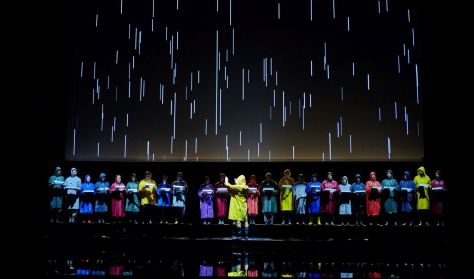
DRIP CANON – How ‘s it going, Heraclitus?
How ‘s it going, Heraclitus?
concert – dance – theatre interference

How ‘s it going, Heraclitus?
concert – dance – theatre interference
Ön egy múltbeli eseményre keresett rá. Kérjük, válogasson aktuális kínálatunkból a Jegy.hu keresőjében!
Last event date: Friday, December 10 2021 7:00PM
The concert:
The wavelengths of a tuned, worn-out piano, a melting drop-shaped glacier, the dripping, the hissing steam combine with the flood of voices from a 17-member chorus.
The dance:
The art of T’ai Chi Ch’uan is a basic element of the performance’s choreography and its spirit as well. The pure, sharp confrontation and balance of rest and flow, qualities in opposition. The state of consciousness of a continuous presence in motion.
The theatre:
Already at the start, in the 80s, we produced a show inspired by the 131 remaining sentence fragments of Heraclitus, the Greek philosopher who lived around 600 BC. When I began to think about our current “anniversary, period-summarising” performance, it occurred to me that I have been in continuous conversation with Heraclitus for 30 years. I write my sentences and direct my shows, which seem like fragments of an imaginary dialogue spanning decades. Slowly, I was forced to realise the driving force behind this performance had to be the (now conscious) dialogue in process that summarised the others – my talks with Heraclitus in the language of Artus.
Hence, this performance may seem like a single motion, a single voice, a single image under continuous transformation.
Drip canon
Man is a drop, Mankind is an ocean.
Two drops together is only one drop.
One drop can only be a drop separately, on its own.
A drop in the ocean ceases to be a drop, for then only the ocean exists.
Separateness ceases.
Stream of thought
Thought is like a stream. I squat on the bank and sometimes draw from it. Thought is the water in my hand. Then, I pour it back. Indeed, who has drawn from this water, and who will do so later? They are my companions. My thoughts are not my own. Others think just the same. I know, because I have read my thoughts in books written centuries, millennia ago. They are my companions: Heraclitus, Lao-Tze, Shakespeare, Hamvas, Weöres, Pilinszky, Eco, Mann and many others. I look at the water in my hand, and I think. Thought cannot be preserved. I pour it back into the stream for others to muse upon. The water is not at rest. It is in motion. At times, it evaporates, but it returns. Thoughts have circulated since time immemorial. Sometimes they get stuck in a person. They are expressed.
(Goda Gábor)
Performers & Creators: Tamás Bakó, Márton Debreczeni, Zoltán Mózes, Csilla Nagy, Melinda Virág
T’ai Chi Ch’uan Artists: Imre Baranyai, László Gregus, Szilvia Izsák
Musicians: Á la cARTe choir (artistic director: György Philipp)
Text: Heraclitus, Gábor Goda
Music Director & Conductor: György Philipp
Set and Visual Design: Ferenc Sebestény, Gábor Goda, Bea Gold
Costume Design: Kriszta Lőrincz
Lighting Design & Co-creator: Gábor Kocsis
Video Animation: Gábor Papp, Ágoston Nagy
Video Tech: Krisztián Megyeri (Kiégő Izzók)
Production Director: Anna Gáspár / Margit Hodovan
Production Assistant: Anna Fazekas
Composers: György Philipp, László Melis
Director & Co-creator: Bea Gold
Director & Choreographer: Gábor Goda
The evoked era in the performance coincides with the time of the original premiere of Swan Lake. At the same time the second half of the 19th century was also a period known for the spreading of mental hospitals; patients 'possessed' by animal spirits and treatments of mental illnesses by torture and other bizarre methods.
“… for they were at hand, yet unreacheable, present, yet ungraspable …” (Krasznahorkai László)
A hétvégi Ringató foglalkozásokra az apukák, nagyszülők és minden szeretett hozzátartozó is el tud jönni énekelni és játszani. Ünnepi hangulatban telnek azok a Ringatók, ahol minden családból több felnőtt is elkíséri a gyerekeket.
Narcissus explores the delicate balance between human relationships and between love and self-love.
Once again, a talented new generation of creative artists with a serious devotion to folk dance has grown up.
Throughout his career, Zoltán Zsuráfszky has been in a dialogue of poems and movements. In his choreographies, the world of…
item(s) in basket
total:
Time limit has expired. Please, put item(s) in to basket again.
